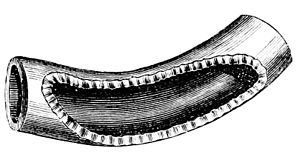and the jaws of a young peccary (Dicotyles nasutus), are of extinct animals. None of the remains have been identified as positively pertaining to our domestic animals, unless two of the teeth may be those of a fœtal or new-born horse. The vegetal remains include a few small fragments of charcoal and seeds of dogwood, pig-nut, and walnut. Remains of human work were found—a large stone celt of hard brown slate, from the bone-earth some distance within the cave; five bone awls, some of them gnawed; the prong of an antler worked so as to be barbed on one side; a needle of bone resembling a crochet-needle; a fish-hook of bone; and a cone-shell, of a species' found on the western coast of Central America, bored through the axis as a head. Professor Leidy has, since exploring this cave, examined a collection of bones in the Museum of the Philadelphia Academy of Natural Sciences, which were found more than thirty years ago in the Durham Cave, Bucks County, Pennsylvania. The bones are of the same character as those of Hartman's Cave.
Temperature of the Breath.—We have before noticed the fact that the effect of breathing upon the bulb of a thermometer through several folds of flannel is to raise the temperature of the thermometer several degrees above that of the mouth and body, and the theory suggested by Dr. Dudgeon to account for the phenomenon, that the breath is the vehicle by which superfluous heat is removed from the body. Dr. William Roberts pronounces this theory untenable, and indicates, as an experiment that will show it to be fallacious, that a naked thermometer placed in the mouth, and breathed upon by expiration, will hardly rise to the normal temperature of that part of the body. He suggests another explanation, which has been accepted by Dr. Dudgeon. It is, that the temperature of the thermometer is raised by the action of the specific heat which is liberated by the condensation of the moisture of the breath. If the experiment of breathing is repeated with the same thermometer and flannel at short intervals, the degree to which the temperature rises decreases with each repetition till at last only a slight effect is produced. This is because the flannel, already charged with moisture, has a diminished capacity for condensing more moisture with every new trial of the experiment. If, on the other hand, the flannel is thoroughly dried before beginning the experiment, an increase of temperature to 115°, or several degrees higher than the highest noted by Dr. Dudgeon, is indicated immediately on breathing upon it. The capacity of the cloth for absorbing moisture has been largely increased by the drying.
Perforation of Lead Pipes by Rats.—We give herewith another well-authenticated case of the perforation of a lead water-pipe by rats, kindly furnished by Mr. Henry C. Hallowell, of Sandy Spring, Maryland. Mr. Hallowell writes: "As the confirmation of a statement is sometimes of value, I send a hasty sketch of a piece of lead pipe in my collection that has been gnawed by rats, as described by Dr. William Eassie, in "The Popular Science Monthly" for January. The pipe is one

Lead Pipe gnawed by Rats.
and one eighth inch in diameter, and the lead three sixteenths of an inch thick. The hole is three inches long, and appears to have been made to get to water."
The Manufacture of Indigo in Bengal.—Indigo is almost entirely obtained from leguminous plants of the genus Indigofera, of which two principal species are grown in India and America. The factories in Bengal are provided with filters, presses, a boiler, drying-grounds, reservoirs, and vats for fermentation. The plant is cut in the morning, and taken to the factory. In the evening it is loaded in the vats, tightly pressed down, and then submerged in water and exposed to a process of fermentation for from nine to fourteen hours. The progress of the fermentation is tested by draw-
